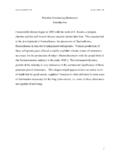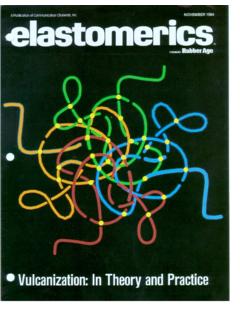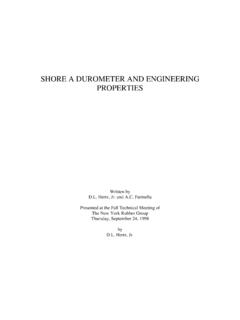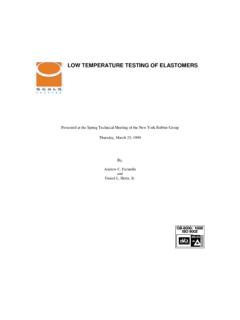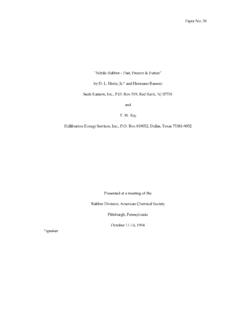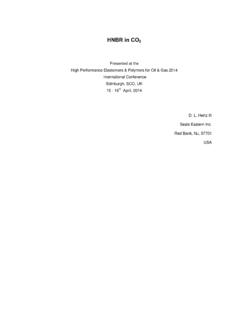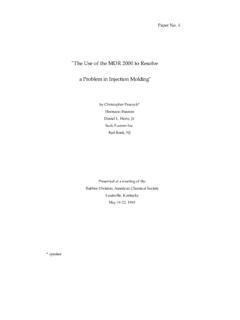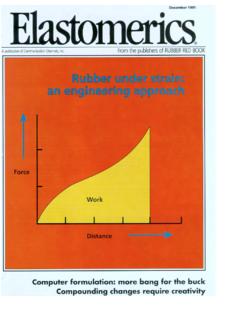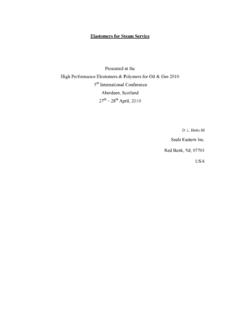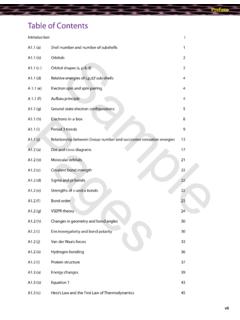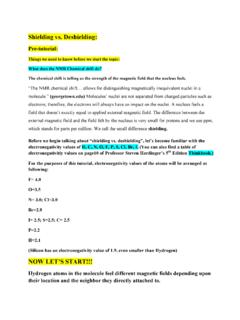Transcription of Elastomers in the Hot Sour Gas Environment - Seals Eastern
1 Elastomers in the Hot Sour Gas Environment Daniel L. Hertz, Jr. President Seals Eastern , Inc. Box 519 Red Bank, 07701 doubly occupied orbital in initiating a reaction" (electron-pair donor-EPD); Neutralization is a coordinate (heterogenic) bond formation between the acid and the base: "All degrees of electron donation are possible, ranging from nearly zero in the case of weak (but specific) intermolecular attractions, and idealized ion associations, to complete transfer of one or more electrons (redox).
2 " The energy changes accompanying these exchanges are difficult to quantify. Guttman(2) has developed actual donor numbers (DN) and acceptor numbers (AN). Methane, carbon dioxide and hydrogen are so dissimilar, one might consider only mixing them together as a capricious trick. Considering the gases first, in a molecular thermodynamic sense, Fig. 1 illustrates the electric charge distribution on the gas molecule. They may be simplistically summarized as follows: Methane Octopole - a uniform (CH4): charge distribution creating a nonpolar molecule.
3 Carbon Quadrupole - strong dioxide negative charges at both (CO2) ends, categorized as a Lewis acid or electron-pair acceptor (EPA agent), or an electrophile. Hydrogen Dipole-created by the 90 sulfide bond angle, categorized as (H2S) a Lewis base or electron pair donor (EPD agent), or a nucleophile. inhibited (neutralized) with bases to prevent corrosion of metal components.
4 Water, CO2 and H2S create aqueous and nonaqueous electrolytes - substances capable of conducting electricity. The existence of electrolytes indicates Lewis acid - base concepts will dictate elastomer/filler/gas responses not previously well defined. Lewis Acid-Base Definitions. A critical survey of Lewis definitions is covered by Jensen in his book, "The Lewis Acid - Base Concepts - An Over view"(I). For our purpose, we will be content to summarize Lewis concepts by quoting Jensen: "An acid is a species that employs an empty orbital in initiating a reaction" (electron-pair acceptor-EPA); "A base is a species that employs a It can be shown that Elastomers have a more predictable swelling response in high-pressure supercritical gases than previously believed.
5 This paper reviews Environment interactions, emphasizing thermodynamic considerations and other concepts to develop a more consistent elastomer/ gas interaction rationale. The Future is Gas, C1 chemistry is being rediscovered as a result of a potentially vast supply of domestic natural gas-methane (CH4). The production conditions are rigorous: Primary Environment dictated by high heat and pressure. Secondary (sour) Environment created by varying percentages of hydrogen sulfide (H2S) and carbon dioxide (CO2), two totally dissimilar gases.
6 The inevitable presence of water often create hydrates (crystalline CH4 - H2O structures) in gas production, unless methanol is injected to serve as an "antifreeze." The acidic production Environment , created by reactions between water, C02 and H2S, have to be Gas Properties. Table I indicates typical production will normally be at temperatures with the gases in their "supercritical state." Defining this statement, consider the following definitions: Critical temperature Tc: Temperature above which gas cannot be liquefied no matter how high the pressure.
7 Critical pressure Pc: Lowest pressure at which gas will liquefy at its critical temperature. Critical molar volume Vc: Volume of mole of gas at the critical temperature. Fig. 2 is a carbon dioxide phase diagram illustrating the critical temperature, critical pressure, and triple point, and the supercritical fluid region. As would be expected, a three-gas mixture phase diagram would be far more complicated and probably does not exist.
8 Understanding the partial pressure rule (refer to any physical chemistry text) does not make the gas predictions quite as daunting, however. Ender's highly original work should be referred to as key references. The Supercritical State This might be best understood by considering water (H20). Water is a liquid at room temperature because it is a very polar molecule. This is created by two conditions: A hydrogen atom attached to an oxygen atom develops the strongest of all intermolecular (as opposed to covalent) attractions.
9 This leads to self-association of H20 molecules creating a liquid state through an h-bond (formerly referred to as a hydrogen bond). Bond angle between HOH is about 109 , causing a net permanent dipole; this creates an additional intermolecular (dipole) attraction. Heating water creates two events: The h-bond is both highly directional and distance sensitive - heat causes separation and bond strength diminishes (2 X distance = 1/64 of original strength).
10 Molecule now begins to rotate (heat is mobile energy of atoms) and rotation of the molecule creates a symmetrical field that averages out the electrical imbalance created by the permanent dipole. The water is now a gas. The intermolecular attractive forces creating the liquid state have been cancelled. At C, it is in the supercritical state. Methanol is similar - adding one oxygen atom to methane (CH4), a gas, now makes it a liquid, (CH3OH).
